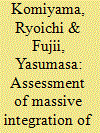|
|
|
Sort Order |
|
|
|
Items / Page
|
|
|
|
|
|
|
| Srl | Item |
| 1 |
ID:
127872


|
|
|
|
|
| Publication |
2014.
|
| Summary/Abstract |
Maximizing renewables in the country's power system has been a key political agenda in Japan after the Fukushima nuclear disaster. This paper investigates the potential of PV resource, which could be systematically integrated into the Japanese power system, using a high time-resolution optimal power generation mix model. The model allows us to explicitly consider actual PV and wind output variability in 10-min time resolution for 365 days. Simulation results show that, as PV expands, the growth of PV integration into the grid slows down when the installed PV capacity is more than the scale of the peak demand, although Japan has immense potential of installable PV capacity - equivalent to 40 times of the peak. Secondly, the results imply that a large-scale PV integration potentially decreases the usage ratio of LNG combined cycle (LNGCC) in specific seasons, which is a challenge for utility companies to ensure that LNGCC is used as a profitable compensating generator for PV variability. Finally, a sensitivity analysis on rechargeable battery cost suggests that the reason for suppressing the PV output instead of storing its surplus output by the battery can be attributed to the high battery cost; hence, the improvement of its economic performance is significant to integrate the massive PV energy.
|
|
|
|
|
|
|
|
|
|
|
|
|
|
|
|
| 2 |
ID:
109428


|
|
|
|
|
| Publication |
2011.
|
| Summary/Abstract |
This paper evaluates the benefits of developing the mini-generation PV market in Portugal. It presents the legal framework and current status of the Portuguese PV electricity sector, and compares the country to other European nations: France, Germany, Greece, Italy, Spain and the United Kingdom. A model that combines PVGIS with a self-developed financial tool is used to assess the feasibility of a 150 kW mini-generation system using five different technologies: fixed mount, single-axis tracking, double-axis tracking, low concentration and medium concentration (MCPV). The profitability of the mini-generation systems in the seven countries studied is calculated and compared. According to this analysis, MCPV and, of the conventional technologies, the single-axis tracking systems are the most profitable technologies. Despite the attractiveness of the current Portuguese feed-in tariffs and of the abundant solar resource, investors are discouraged and the country's PV market is far from mature. Specific mini-generation regulations should focus on a fast and transparent licensing procedure and should promote the access to financing. This would attract new investments, which would result in the growth of the PV electricity produced, and would help Portugal to meet its European Union Renewable Energy targets.
|
|
|
|
|
|
|
|
|
|
|
|
|
|
|
|
|
|
|
|
|